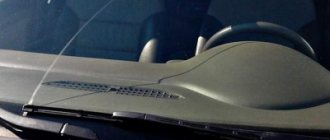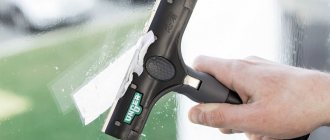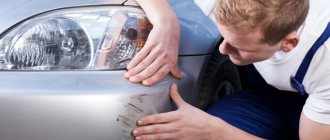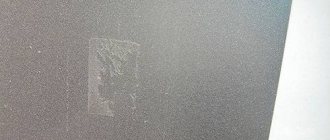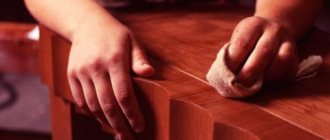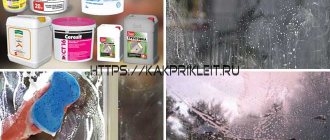Glass as a decorative element for pottery appeared 6 thousand years ago in Egypt and Ancient Babylon. Over so much time, glass materials of various compositions began to be used not only for decoration, household needs and as a finishing material, but also in medicine and industry. The main quality of modern glass of any type is transparency. How to polish glass and return it to crystalline and clear when damaged?
Polishing is the removal of a thin layer of material using an abrasive, chemical reagents, physical-chemical or plasma methods, giving micro-roughness and shine to the glass surface.
Why you might need to polish glass
In industry, there are two methods of polishing glass - coarse and fine. During coarse polishing, the most serious irregularities remaining after rolling rollers are removed. In the process of fine polishing, other, softer forms of influence are used. For example, if in the first case we could talk about metal disks, then at the second stage, felt and similar components usually come into play. Various waterjet and chemical (a mixture of concentrated sulfuric and hydrofluoric acid) technologies make it possible to achieve ideal smoothness and transparency. After this, the glass goes on sale.
If we needed to polish the glass at home, then most likely it’s all about scratches and other defects. In this case, there are several methods, both quite old and based on new technologies, which we will consider below.
Sequence of actions when removing scratches from different objects
If you do all the work step by step and follow these recommendations, the result will blow your mind! The main condition that must be observed before removing scratches is calmness and accuracy.
Glasses
How to polish glasses lenses at home? When making such a decision, you must consider all possible risks and understand that this is not the best option. Any manipulations performed at home can easily lead to the appearance of cloudy spots on the product. These glasses will negatively affect your vision. In this case, you have no choice but to say goodbye to them forever. Seek help from professionals in specialized optical salons.
Important: if you nevertheless decide to “reanimate” the glasses yourself, then use any of the methods described above, having first paid attention to the nature of the damage.
Watch
How to polish the glass on a watch at home to prevent scratches? It is quite possible to repair the damage without resorting to outside help. GOI paste is best suited for these purposes. It is produced under different numbers. We recommend starting with the fourth, which is designed for rough processing of glass surfaces. Rub the glass with it for 2-3 minutes, then remove the remaining product and wipe the surface of the watch dry.
Next, you can use the third number of paste, which contains particles of smaller diameter. When finishing the procedure, you need to polish the dial with paste number one, and then lubricate their surface with mineral oil to give it shine and shine.
Mirrors
A mirror has always been considered an object that requires a particularly reverent attitude. Its surface can be easily scratched and sometimes even broken. It makes no sense to try to glue it together, but anyone can handle minor damage. The principle of operation is very simple: first you need to fill the chips and cracks with the composition, and then polish the surface until the damage completely disappears.
As a filler, you can use GOI paste, tooth or mustard powder, or use others (silicone sealant, epoxy glue, etc.). The same method is suitable for restoring window glass.
Telephone
No matter how carefully you treat your smartphone, sooner or later hateful scratches appear on the screen. The best way to protect against this is to stick a special film or protective glass in specialized salons, but it is not always possible to do this on time. You can correct the situation with improvised means. Toothpaste, vegetable oil and baking soda have proven themselves better than others. As for professional chemicals, GOI paste, Displex and various car polishes can also help you with this.
Plexiglas
Removing scratches from the surface of plexiglass is not difficult; you just need to be prepared in advance for long and painstaking work. Before starting the procedure, we strongly recommend that you stock up on various types of sandpaper and surface polishing products. If your attempts are unsuccessful, then you can always turn to the services of a car service, where specially trained people will professionally polish the glass to perfect condition.
Now you know all the intricacies of working with various types of surfaces, and you have an idea of how to remove scratches from glass. All of the above methods are working and have proven themselves over time. Remember: if an item is of particular value to you, it is better to seek help from specialized centers. We advise you to first study detailed information and read reviews to be completely confident in their competence. Good luck!
Alternative to polishing
If the scratches are not very deep, and there is no desire to do polishing work (especially since this is a rather long and labor-intensive process), then you can use methods for masking scratches. Typically, compositions based on transparent materials with wax-like properties are used for this. But this effect does not last forever, and in the case of major damage it may not help.
Important! If you don’t have any specialized products at hand, which happens quite often, then transparent nail polish would be the ideal solution. Before applying varnish, the surface must be well cleaned. After application, let the varnish dry a little and remove excess using a rubber spatula.
Preparing tools
Polishing to remove scratches can be done using a variety of tools. The ideal solution is a special polishing machine. Its advantage is the wide sole, on which attachments with different softness can be installed. In addition, the machine has the ability to adjust revolutions up to 500 per minute, which in some cases is an important indicator. The power tool is equipped with a main and additional handle, which makes it easier to grip while doing work. In the absence of a specialized tool, a grinder can be used, which also has a speed control. In this case, special care will be required, because even at the lowest speed, the speed remains quite high.
Note! On certain surfaces and glass, the use of high-speed tools is not permitted. This can lead to uneven removal of the top layer, which will affect optical and visual performance.
Hand tools are available to everyone. On sale you can find special fabrics that are used in the process of eliminating scratches. Such fabrics also have a gradation of hardness. You can use felt or felt. If you have untreated leather in your home, you can also use it to gently polish surfaces. Suede from an old jacket or shoes is suitable for these purposes. Polyurethane can be used to carry out the polishing process. In the absence of one of the listed materials, even wood can be used. The manual grouting process will take several times longer than it can be done using a power tool.
Advice! A drill or screwdriver is also great for the polishing process. They have a wide range of speed adjustments and you can find ready-made polishing attachments for them or make them yourself.
Polishing glass using hand tools
To carry out this work, you will need a surface grinder or drill with an appropriate attachment. In addition, we will need to use grinding pastes with different abrasive properties.
Important! In order to remove a scratch, we will need to smooth its lower level with the rest of the surface, or remove sharp corners that change the parameters of light refraction and make the scratch visible. To do this, we first polish with a grinding paste with the largest particles that have the greatest abrasive properties. Then we gradually reduce the abrasive properties to minimum. At the final stage, polishing is carried out with cloth or felt without any paste. Of course, the abrasive paste is applied with periodic wetting with water. To do this, you can use a spray bottle.
Processing thick glass
Before polishing, you need to sand the surface. Glass grinding is done using sandpaper or medium-grain paste. Gradually you need to switch to pasta with finer grains. This is a long process, but the result will please you!
Unfortunately, sometimes the damage is so serious that it is easier to buy or order a new item or design.
You can order partitions, fences, glass doors, shower cabins, stairs, glass canopies, ERAGLASS glass partitions for offices and much more by calling us at ERAGLASS.
Share
How to remove small scratches on windows and watch crystals
- Toothpaste is a kind of folk method. Contains a sufficient amount of abrasive substances if it has a whitening effect. It should not be confused with gel, as it is not intended for such purposes. You can work manually, without any tools. Take a cotton pad with paste and start making circular movements in both directions. After the paste has dried, all that remains is to wash it off;
- Car glass polishes are a very effective way to remove even deeper scratches. Before use, it is recommended to test in a less visible area to ensure that the window glass reagents contained there are safe. The reason is the large number of similar polishes. As for the technique, it is identical to that described above;
- Paste of the State Optical Institute (GOI). An old polishing product that we inherited from Soviet times and first hit the market in the early 30s of the last century. A universal tool that can be used to grind not only glass, but also polymers, metals and much more. In the USSR and Russia, entire generations used this paste. However, it is now more difficult to get it, as there are many fakes on the market.
What you need to polish your windshield yourself
So, let's figure out what and how you can polish your windshield from car scratches at home? It is important to understand here that glass is a material that is more difficult to work with because it cannot be polished as easily as the rest of the car body. To perform this task, you will definitely need a polishing machine, to which you can connect a channel to supply water to the processing site, which will successfully combat sudden temperature changes on the glass during friction.
Polishing machine
In addition, you will need to stock up on:
- abrasive polishing paste;
- masking tape;
- film or any other protective cover for adjacent parts of the car;
- microfiber cloths;
- glass cleaners;
- a regular spray bottle with water;
- marker.
Pros and cons of DIY polishing
When polishing your windshield for the first time, you will get impressive results as the clarity of the old windshield will be equal to the new one. Subsequent polishings will give a more modest result, but the consolation is that they will be practically free, taking into account the previously purchased materials. This is a definite plus.
When choosing how to polish a windshield with your own hands, it is better to use practice-tested materials and methods, because otherwise you may get the opposite result.
A disadvantage of manual work is also considered to be the long duration of the process, which requires constant monitoring of the polishing progress to eliminate negative results.
If you are unsure of your professional abilities regarding polishing a windshield, practice suggests the rationality of seeking help from a car service center.
Carrying out a comparative calculation of polishing the windshield yourself and with the help of a car service, we get approximately the same amount of costs. But do not forget that you can use the material you purchased for home glass polishing several times to polish not only the windshield, but also the headlights, body, and other parts of the car.
Step by step polishing process
The polishing process requires the availability of the necessary materials, and when producing it yourself, also the appropriate tools, inclusive:
- special paste or powder for polishing windshields;
- polishing machine with special felt wheels;
- polyethylene film for covering the car body;
- glass cleaner and a set of wipes;
- a good spray bottle or atomizer;
- masking tape and marker.
Along with visual diagnostics, we check the depth of scratches on the glass using a fingernail:
- if the edge of the nail does not cling to the protrusion of the scratches, then it is advisable to use a paste that removes a layer of 1 micron;
- if the edge of the nail clings well to the scratch, then it is recommended to remove it using a photopolymer, since polishing is ineffective here;
- cracks, chips, deep scratches and other large defects also cannot be removed by polishing, but require other processing methods.
Direct polishing of the windshield includes the following steps:
- We visually inspect the surface of the glass to detect damage of varying degrees, such as chips, scratches, air pockets, etc. We mark these zones using a marker on the inside of the windshield.
- We fix the plastic film on the car body to prevent it from being contaminated by paste, powder or polishing dust.
- We do a preliminary cleaning and wash the glass using glass detergents and wipe it until dry.
- According to the instructions for use, dilute the polishing paste or powder to the desired consistency.
- Apply 2-3 tablespoons of paste evenly onto the plane of the polishing felt wheel and begin polishing, covering the area of glass with damage of 25x25cm. We make slow circular movements over the intended area, periodically spraying the paste on the surface of the glass and felt with a spray bottle or spray bottle to prevent them from drying out and the formation of new scratches.
- When performing polishing movements, the pressure on the glass should be minimal and distributed over the intended area to prevent the formation of a lens effect on the surface of the windshield.
- After polishing, we perform a visual inspection of the working part and, if matte areas are detected, we carry out repeated careful polishing until they disappear.
It is difficult to determine the polishing time in advance. It all depends on the quality of the glass and the extent to which it has damaged areas that require polishing.
You also need to remember that polishing a windshield with your own hands is not something to be rushed, but requires scrupulous attention to avoid damage to the glass. Basically, this process takes about 3 hours.
Preparatory work
An important step is cleaning the glass from dirt. For this purpose, there is a large selection of auto chemicals that effectively remove grease and other contaminants. Mineral deposits, automotive oils, environmental pollutants and various other agents affect the quality of the polish.
The windshield must be thoroughly washed and wiped dry with a microfiber cloth.
Next, you need to identify areas for polishing and outline them with a marker. This is done to be able to polish only the area that needs it. The applied reagent will not allow you to effectively determine the location of damage, so the indication of such areas is a fundamentally important point. If polishing is necessary for the entire glass, it is not necessary to highlight the damaged areas with a marker.
A very important point is to protect the paint surface of the car body from the ingress of reagents (Goi paste), the ingress of which causes corrosion and destruction of the car’s paint base. To do this, all adjacent surfaces, including the roof, are covered with plastic film using masking tape.
Reagent application
After completing the preparatory work, begin polishing. To do this, a reagent is applied to the damaged areas. As a rule, it must be applied in a circular motion, evenly distributing it over the surface.
Important! It is necessary to polish the windshield of a car using personal protective equipment - since the reagents are toxic substances that cause irritation to the skin and negative health consequences if suspended particles of the substance enter the respiratory tract.
Video: how to polish a windshield
Automotive glass polishing
Before you begin polishing, you must thoroughly rinse the glass using a special product and wipe it first with a wet and then a dry cloth that does not leave marks. If scratches are difficult to see, they can be detected by touch and then outlined in some way. The polishing itself is carried out using an abrasive paste and hand tools - the process is described above.
Polishing your car glass is extremely important, as scratches on this element greatly reduce visibility. Therefore, there is no need to delay this. And, if you are still not confident in your abilities, then it is better to entrust the process to professionals who probably work in your city.
How to polish glass and mirror
A number of types of glass are used in construction, differing in thickness and optical energy characteristics. High-quality window glass is colorless, with a high light transmittance. There are two types:
M4 - polished float glass, which is produced by casting a molten glass strip onto molten tin in a certain atmospheric environment and temperature. M5 and M6 are made using the “old-fashioned” vertical method of drawing between rollers.
Heat-saving glasses are opaque; the reflective coating gives a slight “haze”. Laminated - have a tint. It is not advisable to polish them. It is also better not to subject tempered glass to mechanical processing. Ordinary glasses are transparent to radiation in the optical range of electromagnetic waves, for which they are valued. Minor damage to them does not affect the illumination, but spoils the aesthetics of the room and the mood of the inhabitants.
If the scratches are small, “hairline”, then you can try polishing the transparent glass. If the grooves remain deep, they cling with a fingernail, or they are scale from the grinder, then it is better to change the double-glazed window. Since during processing the material will become thinner in one place and crack.
In double-glazed windows, thermopolished glass is more often used, on which, with additional grinding, a lens is formed, which will be visible in a visible place.
Just like window glass, mirrors are polished if they are damaged on the outside. In this case, a “lens” effect may also occur. Sometimes, it is better to sandblast a design than to polish a mirror to remove scratches. But you should choose a picture so that the scratch is located on the border of the stencil image, because sandblasting will deepen the defect.
Ways to prevent scratches on glass
- The favorite method of washing glass, which uses newspapers, is actually unacceptable. If our ancestors could still do this without damaging the glass surface, now rough paper and ink with many impurities are allowed in the production of newspapers. All this makes such a product a real abrasive;
- Various washing or cleaning powders are best used only if they are completely soluble in water. Otherwise, their particles will cause damage to the glass;
- To wash glass, it is recommended to use soft materials that do not leave marks, as well as products specially created for this purpose. The latter are constantly being improved, so that their ability to clean glass surfaces safely has increased greatly in recent years;
- If during the glass washing process aggressive cleaning agents or hot water were used, then after washing it is not recommended to wipe them with hard, dry rags. This approach practically guarantees scratches on the glass.
Why do scratches appear?
The main reasons for the formation of chips:
- cleaning with newsprint—newspaper ink contains heavy metals and the paper is too hard;
- sudden changes in temperature;
- wiping with hard or fleecy material;
- ingress of abrasive particles onto the surface;
- washing with alcohol-containing solutions;
- mechanical damage.
The pros and cons of glass polishing
High-quality polishing requires removal of the entire outer layer. Its depth depends on the size of the chip being removed. If the procedure is carried out unevenly, the windshield will begin to work on the principle of a magnifying glass, which can lead to an inaccurate perception of the road situation by the driver.
Contacting a master is expensive, perhaps more expensive than pasting in the original. Polishing makes sense if:
- the price of a new part is more than 20 thousand rubles;
- there are no serious cracks or chips;
- The windshield is very rare.
Arguments against restoration:
- replacement cost does not exceed 10 thousand rubles;
- polishing yourself can damage the surface;
- there are no suitable tools or skills to work with them.
Considering these factors, it is easier to decide whether the glass can be polished or whether the glass needs to be replaced.
Helpful information
To ensure that the process of removing scratches from glass is successful, you need to adhere to the following recommendations:
- Before applying the new composition to the central part of the glass, you need to test it on an inconspicuous area.
- Do not press too hard on the surface to avoid damaging the window.
- To treat a small area, use very little product.
- Movements during polishing should be smooth and circular.
- It is not necessary to buy glass polish; you can use compositions for furniture or car bodywork.
- To ensure that the polishing effect lasts as long as possible, it is not recommended to use newspapers and hard towels for cleaning windows.
- Any compositions are applied to pre-cleaned glass. Dust and dirt on it can cause new scratches.
You will find a lot of important and useful information about fast and effective window cleaning in this section.
How to polish a watch
Before starting the procedure, it is advised to remove the glass from the device (this will make it more convenient to carry out polishing work). If this is not possible, then remove the strap. The device is then placed on a flat surface.
This is a mandatory condition, because when using a grinding machine, the watch can be damaged if it is at an angle.
- A soft cloth is also used for work, which will help remove traces of activity.
- Polishing, regardless of method, takes an average of 20 minutes.
- If this is not enough, the procedure is repeated again.
What to do?
Of course, you can take a risk and try to polish the windshield, despite the risks described above. But you need to remember that glass is “younger” and does not become stronger because of this, but only the opposite. And the recurrence of problems in the form of scratches and abrasions becomes even more likely. And in our opinion, it’s not worth investing money in a part that will return to its original state in a short amount of time.
Therefore, the most economically feasible solution is to replace the windshield. And of course, taking into account previous operating errors.
Sources
- https://KuzovExpert.ru/polirovka/stekla-avtomobilya-ot-tsarapin.html
- https://autochainik.ru/mozhno-li-otpolirovat-lobovoe-steklo.html
- https://vetro.pro/post/windshield-polishing
- https://rad-star.ru/pressroom/articles/chem-otpolirovat-lobovoe-steklo/
- https://autoot.ru/polirovka-lobovogo-stekla-ot-carapin.html
- https://okuzove.ru/polirovka/mozhno-li-polirovat-lobovoe-steklo-avtomobilya.html
- https://bumper.guru/klassicheskie-modeli-vaz/poleznoe/kak-ubrat-carapiny-s-lobovogo-stekla.html



